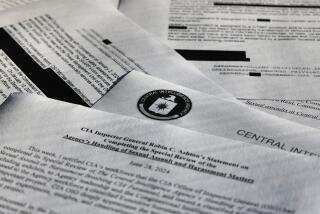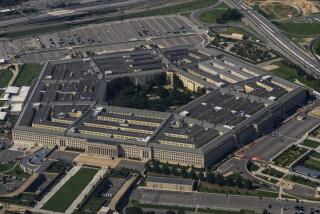CIA Can Still Get Tough on Detainees
WASHINGTON — New U.S. policies on the treatment and interrogation of terrorism suspects outlined this week by the Bush administration mean that the military no longer will resort to harsh or extreme methods to obtain information -- but that the CIA could.
The new administration approach, first presented by President Bush in a speech Wednesday and detailed later by administration and military officials, followed an internal administration debate over the question of how best to extract intelligence from the most notorious suspects apprehended in the war on terrorism.
But by assigning the CIA to use tough, undefined methods on some detainees, the policy outlined by Bush may raise new questions about U.S. procedures and invite more criticism from human rights advocates and allies.
For the five years after the Sept. 11 attacks, the administration’s top leaders and senior policymakers have supported the use of harsh methods to obtain information that could head off future attacks and save lives. But military officers have insisted that such interrogation tactics are unproductive -- and inevitably lead to abuse.
On Wednesday, after years of internal debates, the administration outlined a compromise meant to reconcile the position of hard-liners and military traditionalists.
The Army, morally and culturally averse to using unorthodox interrogation methods, will get out of the business of using tough tactics against detainees under the compromise. The new Army field manual authorizes only 19 interrogation techniques and bans the most controversial tactics that critics said amounted to torture -- hooding prisoners, conducting mock executions, and strapping detainees to boards and using water to simulate drowning.
But the CIA will reserve the right to use the tougher tactics. Bush said such methods had been effective in getting some of the 14 top Al Qaeda suspects held by the agency to talk. Administration officials said the CIA tactics would be legal and fall well short of torture and abuse. But the president and others have pointedly refused to say what those tougher methods might be.
The compromise may satisfy the military, which can now say its soldiers will always comply with international treaties and steer well clear of torture. But it is not certain whether the new policy will satisfy those who have raised questions about American interrogation practices, including human rights advocates and members of Congress.
On Capitol Hill, lawmakers and aides have expressed frustration that they have not been told what the CIA techniques were and whether the agency would adhere to the ban on torture.
“We don’t know what the methods are; that is where the difficulty lies,” said a congressional aide who asked not to be identified because of the sensitivity of the debate. “Although the Department of Defense techniques, bar none, are articulated openly, with the CIA there is no way to judge whether those techniques satisfy the ban on cruel and degrading treatment.”
Human rights advocates applauded the military’s embrace of Geneva Convention protections and the Army’s decision to make public its interrogation tactics. But they worried that congressional approval of a CIA detention program that was secret and allowed a broad range of harsh techniques would be a step backward.
“They have decided to take the military out of the torture business and leave that to the CIA, and that is extremely problematic,” said Jumana Musa, an advocacy director for Amnesty International.
Administration officials said the new policy ensured that the toughest techniques were reserved only for the most experienced interrogators and used only on the most notorious suspects.
“The president made clear this is a small program targeting a certain category of high-level Al Qaeda members,” said a senior administration official speaking on condition of anonymity because of the deliberations involved.
Senior Pentagon officials suggested that creating separate rules for the CIA and the military represented a logical division of labor.
“Each of us has our task to do,” Stephen A. Cambone, the undersecretary of Defense for Intelligence, said in an interview Thursday.
For the uniformed military, disclosing interrogation tactics and outlining protections detainees will be afforded was vital to assuring the public that the military was doing all it could to ensure there would be no repeat of the Abu Ghraib prisoner abuse scandal.
“The military really felt it has been tarnished by events at Abu Ghraib and other detainee abuses,” said an administration official. “They want to restore a certain image, and so for them there is a greater interest in being able to speak with a great deal of transparency.”
Military leaders argued this week that they did not believe abusive tactics worked in extracting information.
“No good intelligence is going to come from abusive practices. I think history tells us that. I think the empirical evidence of the last five years, hard years, tell us that,” said Lt. Gen. John Kimmons, the Army’s deputy chief of staff for intelligence.
Information extracted by abusive tactics was of questionable credibility, Kimmons said. Moreover, any good that came from the information would be undercut by the damage to America’s reputation once the abuse became known.
“And we can’t afford to go there,” he said.
Kimmons’ comments reflect a common refrain among instructors at the Army intelligence academy at Ft. Huachuca, Ariz. Nevertheless, many interrogators privately acknowledge that coercive methods that stop short of torture have proven effective in Afghanistan and Iraq.
In Afghanistan, for instance, interrogators who questioned prisoners early in the war complained that they had little success with straightforward approaches, and only began to get meaningful information from prisoners after embracing harsher methods, including short-term deprivation of sleep.
Over time, those harsher techniques came to include putting prisoners in “stress positions” and placing hoods on their heads -- all explicitly banned by the new Army field manual.
The new manual allows 19 interrogation methods. Cambone said officers were asked if they needed more than the 19 approved techniques. They said they did not.
“They are of the view that the manual gives them what they need to do the job,” Cambone said.
Most of the Army’s methods are traditional approaches that were included in the old manual -- techniques called “ego-up,” where detainees with low self-esteem are flattered into revealing information; or “fear-up,” where interrogators try to play off a pre-existing fear or anxiety of a detainee and suggest that the soldier could help the detainee.
New techniques include one called “Mutt and Jeff” -- essentially a good cop, bad cop routine -- and “false flag,” in which an interrogator pretends not to be a U.S. citizen.
The new manual includes one restricted technique that will only be used on so-called unlawful combatants -- such as Al Qaeda suspects -- not traditional prisoners of war.
That technique, called “separation,” involves segregating a detainee from other prisoners. Military officials said separation was not the equivalent of solitary confinement and was consistent with Geneva Convention protections.
A four-star general would need to approve the use of the separation tactic to ensure it was not abused, Kimmons added.
Disclosing the Army’s techniques was controversial within the Pentagon, and Kimmons acknowledged that the military had wrestled with the idea of keeping some of them secret. But he said the reality was that the interrogation techniques were not the kind of secret that could be kept forever.
“Even classified techniques, once you use them on the battlefield over time, become increasingly known to your enemies, some of whom are going to be released in due course,” Kimmons said Wednesday.
For the CIA, immersed in a culture of secrecy, the sort of disclosure the Army made this week is anathema.
Agency officials believe that talking about what methods are allowed or not allowed undercuts their ability to question terrorists.
Administration officials acknowledged Thursday that as long as the CIA did not follow the Pentagon lead and disclose its methods, questions would persist.
“The fact that they are not disclosing means there is going to be skepticism,” said an official who spoke on condition of anonymity because of government rules.
Nonetheless, the CIA is better equipped to seek intelligence from difficult suspects, others said.
“With the CIA, you are only talking about a narrow group,” the senior administration official said. “You don’t have a problem of techniques falling in the hands of an interrogator who doesn’t have a lot of training.”
But Musa, the Amnesty lawyer, said several CIA contractors had been accused of beating detainees to death, and there was little evidence that the agency’s interrogators could be trusted with tougher tactics.
“Anytime anyone has danced up to the line,” she said, “they have crossed over it.”
Times staff writer Greg Miller contributed to this report from Washington.
More to Read
Get the L.A. Times Politics newsletter
Deeply reported insights into legislation, politics and policy from Sacramento, Washington and beyond. In your inbox three times per week.
You may occasionally receive promotional content from the Los Angeles Times.










